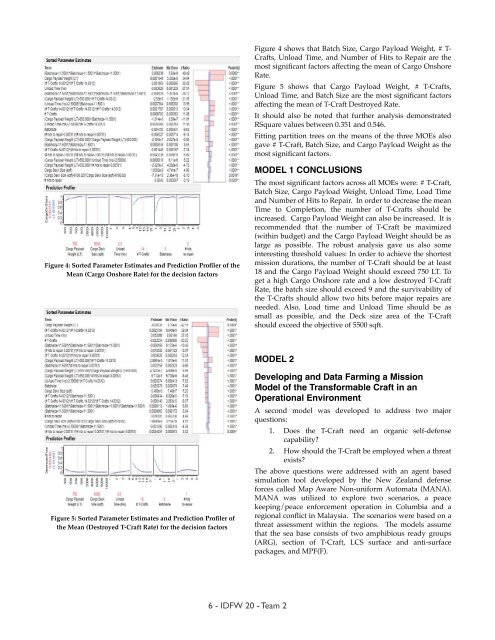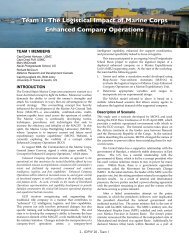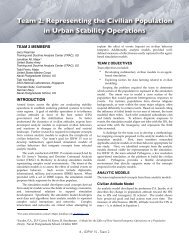pdf file - SEED Center for Data Farming - Naval Postgraduate School
pdf file - SEED Center for Data Farming - Naval Postgraduate School
pdf file - SEED Center for Data Farming - Naval Postgraduate School
You also want an ePaper? Increase the reach of your titles
YUMPU automatically turns print PDFs into web optimized ePapers that Google loves.
Figure 4 shows that Batch Size, Cargo Payload Weight, # T-<br />
Crafts, Unload Time, and Number of Hits to Repair are the<br />
most significant factors affecting the mean of Cargo Onshore<br />
Rate.<br />
Figure 5 shows that Cargo Payload Weight, # T-Crafts,<br />
Unload Time, and Batch Size are the most significant factors<br />
affecting the mean of T-Craft Destroyed Rate.<br />
It should also be noted that further analysis demonstrated<br />
RSquare values between 0.351 and 0.546.<br />
Fitting partition trees on the means of the three MOEs also<br />
gave # T-Craft, Batch Size, and Cargo Payload Weight as the<br />
most significant factors.<br />
Figure 4: Sorted Parameter Estimates and Prediction Pro<strong>file</strong>r of the<br />
Mean (Cargo Onshore Rate) <strong>for</strong> the decision factors<br />
MODEL 1 CONCLUSIONS<br />
The most significant factors across all MOEs were: # T-Craft,<br />
Batch Size, Cargo Payload Weight, Unload Time, Load Time<br />
and Number of Hits to Repair. In order to decrease the mean<br />
Time to Completion, the number of T-Crafts should be<br />
increased. Cargo Payload Weight can also be increased. It is<br />
recommended that the number of T-Craft be maximized<br />
(within budget) and the Cargo Payload Weight should be as<br />
large as possible. The robust analysis gave us also some<br />
interesting threshold values: In order to achieve the shortest<br />
mission durations, the number of T-Craft should be at least<br />
18 and the Cargo Payload Weight should exceed 750 LT. To<br />
get a high Cargo Onshore rate and a low destroyed T-Craft<br />
Rate, the batch size should exceed 9 and the survivability of<br />
the T-Crafts should allow two hits be<strong>for</strong>e major repairs are<br />
needed. Also, Load time and Unload Time should be as<br />
small as possible, and the Deck size area of the T-Craft<br />
should exceed the objective of 5500 sqft.<br />
MODEL 2<br />
Figure 5: Sorted Parameter Estimates and Prediction Pro<strong>file</strong>r of<br />
the Mean (Destroyed T-Craft Rate) <strong>for</strong> the decision factors<br />
Developing and <strong>Data</strong> <strong>Farming</strong> a Mission<br />
Model of the Trans<strong>for</strong>mable Craft in an<br />
Operational Environment<br />
A second model was developed to address two major<br />
questions:<br />
1. Does the T-Craft need an organic self-defense<br />
capability?<br />
2. How should the T-Craft be employed when a threat<br />
exists?<br />
The above questions were addressed with an agent based<br />
simulation tool developed by the New Zealand defense<br />
<strong>for</strong>ces called Map Aware Non-uni<strong>for</strong>m Automata (MANA).<br />
MANA was utilized to explore two scenarios, a peace<br />
keeping/peace en<strong>for</strong>cement operation in Columbia and a<br />
regional conflict in Malaysia. The scenarios were based on a<br />
threat assessment within the regions. The models assume<br />
that the sea base consists of two amphibious ready groups<br />
(ARG), section of T-Craft, LCS surface and anti-surface<br />
packages, and MPF(F).<br />
6 - IDFW 20 - Team 2




